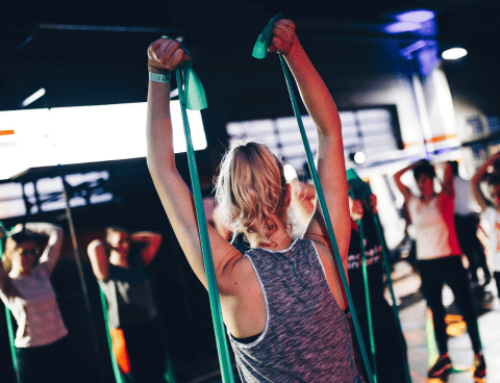Want to Increase Your Vertical? Train With Drop Jumps
If maximal strength work alone could increase your vertical, athletes could improve with only P90X. The old adage that you can jump higher if you can squat 1.5 times your body weight is somewhat true, but a recent study found that speed-strength is actually more important.(1)
The findings suggest that speed-strength correlates significantly with both standing counter movement jumps and run-up vertical jumps, whereas maximum strength does not.(1) This means that although athletes need max strength work, there is more to developing jumping ability than max strength.
If you truly want to increase your vertical, you must:
- Learn how to land properly and then jump (see the Dos and Don’ts of Plyometrics)
- Train with Drop Jumps (DJ) to strengthen your muscles’ strength shortening cycle (SSC)
A combination of concentric-eccentric contractions, the SSC trains muscles for the three phases in a plyometric sequence: the concentric (jump), the amortization (transition) and the eccentric (landing). When the Journal of Strength and Conditioning Research compared the effects of training program using Squat Jumps to one that combined Squats and DJs, the squat jump group attained a 5.8% improvement and the combined group improved by 10.2%. Bottom line: DJ training is more useful for improving your vertical performance.
Drop Jumps should be done from heights of 20-40 cm. These have the highest rate of force development (RFD).(3) These heights may seem low, but the higher the box, the longer the time needed to decelerate and land.(4)
Combine this training with some max strength training, and you will have your vertical going through the roof.
References
(1) Young, Warren, G. Wilson, and C. Byrne. “Relationship Between Strength Qualities and Performance in Standing and Run-up Vertical Jumps.” Journal of Sports Medicine and Physical Fitness 39 (1999): 285-293. Print.
(2) Lyttle, AD, GJ Wilson, and KJ Ostrowski. “Enhancing performance: maximal power versus combined weights and plyometrics training.” Journal of Strength and Conditioning Research 10.3 (1996): 173-179. Print.
(3) Young, WB, and GE Bilby. “The effect of voluntary effort to influence speed of contraction on strength, muscular power, and hypertrophy development.” Journal of Strength and Conditioning Research 7.3 (1993): 172-178. Print.
(4) Schmidtbleicher, D. “Training for power events.” Oxford: Blackwell Scientific Publications 1 (1992): 381-395. Print.
RECOMMENDED FOR YOU
MOST POPULAR
Want to Increase Your Vertical? Train With Drop Jumps
If maximal strength work alone could increase your vertical, athletes could improve with only P90X. The old adage that you can jump higher if you can squat 1.5 times your body weight is somewhat true, but a recent study found that speed-strength is actually more important.(1)
The findings suggest that speed-strength correlates significantly with both standing counter movement jumps and run-up vertical jumps, whereas maximum strength does not.(1) This means that although athletes need max strength work, there is more to developing jumping ability than max strength.
If you truly want to increase your vertical, you must:
- Learn how to land properly and then jump (see the Dos and Don’ts of Plyometrics)
- Train with Drop Jumps (DJ) to strengthen your muscles’ strength shortening cycle (SSC)
A combination of concentric-eccentric contractions, the SSC trains muscles for the three phases in a plyometric sequence: the concentric (jump), the amortization (transition) and the eccentric (landing). When the Journal of Strength and Conditioning Research compared the effects of training program using Squat Jumps to one that combined Squats and DJs, the squat jump group attained a 5.8% improvement and the combined group improved by 10.2%. Bottom line: DJ training is more useful for improving your vertical performance.
Drop Jumps should be done from heights of 20-40 cm. These have the highest rate of force development (RFD).(3) These heights may seem low, but the higher the box, the longer the time needed to decelerate and land.(4)
Combine this training with some max strength training, and you will have your vertical going through the roof.
References
(1) Young, Warren, G. Wilson, and C. Byrne. “Relationship Between Strength Qualities and Performance in Standing and Run-up Vertical Jumps.” Journal of Sports Medicine and Physical Fitness 39 (1999): 285-293. Print.
(2) Lyttle, AD, GJ Wilson, and KJ Ostrowski. “Enhancing performance: maximal power versus combined weights and plyometrics training.” Journal of Strength and Conditioning Research 10.3 (1996): 173-179. Print.
(3) Young, WB, and GE Bilby. “The effect of voluntary effort to influence speed of contraction on strength, muscular power, and hypertrophy development.” Journal of Strength and Conditioning Research 7.3 (1993): 172-178. Print.
(4) Schmidtbleicher, D. “Training for power events.” Oxford: Blackwell Scientific Publications 1 (1992): 381-395. Print.











